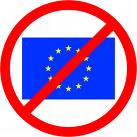Difference between revisions of "The Blame Game"
GudmunudurKr (talk | contribs) |
|||
| Line 1: | Line 1: | ||
==The scenario== | ==The scenario== | ||
[[Image:No_EU.jpg|thumb|right|600px]] | [[Image:No_EU.jpg|thumb|right|600px]] | ||
The year is 2030 and the European Union is only a shadow of its glorious past. The region is still feeling the impact of the 2009 financial crisis which led to a depression in Europe. | |||
The | The billions of Euro pumped into the financial market by the richer nations, helped the economy to stabilize in the beginning and it showed signs of recovery. But, the recovery was long drawn and the rich nations were not able to sustain the financial flow and started withdrawing the money released, to divert it to other economic requirements. After all, each country had its own problems to cop with. | ||
The EU was also unable to sustain subsidising the lesser developed member states. This caused wide spent resentments among member nations. With rising unemployment levels and falling standards of living, member nations turned their focus inward and adopted more socialistic practices. | |||
People started re-looking at their identity. Till that time they believed in a unified EU, but as the EU was not able to keep the ship afloat, richer members considered the option of being the first to part ways so that they could be able to serve their people better. | |||
That was the beginning of the disintegration. | |||
People started re-looking at their identity. Till that time they believed in a unified EU, but as the EU was not able to keep the ship afloat, richer members considered the option of being the first to part ways so that they could be able to serve their people better.That was the beginning of the | |||
== Timeline == | == Timeline == | ||
Revision as of 19:40, 13 October 2009
The scenario
The year is 2030 and the European Union is only a shadow of its glorious past. The region is still feeling the impact of the 2009 financial crisis which led to a depression in Europe.
The billions of Euro pumped into the financial market by the richer nations, helped the economy to stabilize in the beginning and it showed signs of recovery. But, the recovery was long drawn and the rich nations were not able to sustain the financial flow and started withdrawing the money released, to divert it to other economic requirements. After all, each country had its own problems to cop with.
The EU was also unable to sustain subsidising the lesser developed member states. This caused wide spent resentments among member nations. With rising unemployment levels and falling standards of living, member nations turned their focus inward and adopted more socialistic practices.
People started re-looking at their identity. Till that time they believed in a unified EU, but as the EU was not able to keep the ship afloat, richer members considered the option of being the first to part ways so that they could be able to serve their people better.
That was the beginning of the disintegration.
Timeline
Period of 2010 - 2015
The bottom of the credit crisis seemed to stay behind in the end of 2009. Small signs of economic recovery were improving citizen confidence for the following years. The news about other countries that had recovered such as China, Australia and Brazil were fullfiling of hope the population in Europe. However, the prevision of economists were predicting a stronger hit in the economy of major developed coutries. Unfotunately, they were right. The bubble burst again in the beggining of 2011.
Regulations in the financial sector weren't enough to contain a second and fatal collapse of major banks. Government had to inject huge amount of money in financial institutions to guarantee their deposits. Unemployment rose up to 20% in Spain and the UK.
The pessimim and panic spread out throughout Europe and a felling of uncertainty regarding the future explained several actions taken by individuals and governments to protect themselves. With the lack of confidence in the financial sector people started to withdraw their money from the banks. The bank run required immediate intervention from government, but promises that government would guarantee people's deposits did not stop individuals' wiliness to hold their money during the new turmoil. Meanwhile, companies not only stoped investing in new projects but also started divesting their assets. Prices went down rapidly. Consumption decreased.
The economic meltdown was lasting longer than expectations and signs of recovery did not seem to appear in a near future.
New politic parties came up with different types of reforms and proposals. People did not believe in the capitalit way of life anymore. Left wing parties started gaining power and support from voters.
